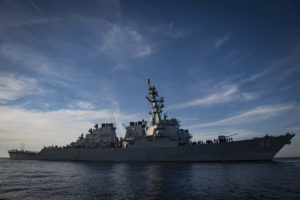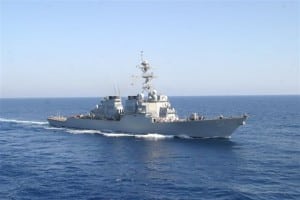U.S. military forces recently destroyed over 80 one-way uncrewed aerial vehicles (UAV)s and ballistic missiles meant to target Israel in retaliation for Israel’s recent attack on an Iranian consulate in Syria.
An April 14 U.S. Central Command (CENTCOM) press release said American forces destroyed over 80 explosive UAVs and at least six ballistic missiles launched from both Iran and Houthi-controlled areas of Yemen.

Iran launched the attack in retaliation for a recent Israeli strike on Iran’s consulate in Damascus, Syria.
An April 14 statement from CENTCOM said the U.S. activities included destroying one ballistic missile on its launcher vehicles and seven UAVs destroyed on the ground in Yemen before they could be launched.
In a press conference Monday, DoD press secretary Maj. Gen. Patrick Ryder said on the night of April 13 and morning of April 14, Iran and its proxies launched more than 300 total air threats from locations in Iran, Iraq, Syria and Yemen targeting Israel, with over 80 threats specifically downed by U.S. forces.
Ryder said this action included over 110 medium-range ballistic missiles, over 30 land-attack cruise missiles and over 150 UAVs.
He confirmed CENTCOM forces defending Israel included support from the Arleigh Burke-class destroyers USS Arleigh Burke (DDG-51) and USS Carney (DDG-64). Both ships include ballistic missile defense capabilities with Standard Missile-3 interceptors, but the Pentagon did not disclose specific systems used.
DDG-51 is currently based on Rota, Spain as part of Forward-Deployed Naval Forces-Europe, which is part of the European Phased Adaptive Approach to ballistic missile defense for the region, aimed at defense against Iranian threats. DDG-64 was previously stationed in Rota for the same mission.

Ryder also acknowledged both land and sea-based U.S. fighter jets were involved in the defensive operation to take out some of the UAVs, but claimed he could not go into specifics of numbers of fighters used due to operational security.
On April 13, the White House announced President Biden directed the military to move additional aircraft and ballistic missile defense destroyers to the region in the past week to help defend Israel in this manner, including DDG-51 and DDG-64.
Ryder said any Israeli response is for its government to decide but reiterated Secretary of Defense Lloyd Austin has both publicly and privately said “we don’t want to see escalation, but we obviously will take necessary measures to protect our forces in the region. And as was demonstrated over the weekend, we’ll take necessary measures to defend Israel.”
He said the Pentagon will “learn a lot from this and we have learned a lot from this,” but underscored that 99% of the over 300 Iranian air threats launched were knocked down.
“It is demonstrative of that close coordination and synchronization between the United States and coalition partners when it comes to addressing air defense threats in the region,” Ryder said.
While the Pentagon acknowledged the French and British participated in the defense, he would not specify any regional countries that reportedly participated, like Jordan.
When pushed on what regions of Iraq were used to launch Iranian-aligned attacks, Ryder only disclosed one ballistic missile was “taken down in the vicinity of Erbil.”